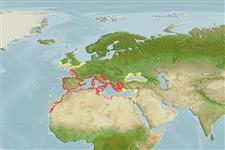>
Atheriniformes (Silversides) >
Atherinidae (Silversides) > Atherininae
Etymology: Atherina: Greek, atherina, the Greek name for the eperlane; 1770 (Ref. 45335).
More on author: Risso.
Environment: milieu / climate zone / depth range / distribution range
بوم شناسي
دريايي; آب شيرين; لب شور نزديك كف زي; هردو رو (Ref. 59043); تغييرات عمق 1 - ? m. Subtropical; 53°N - 20°N, 18°W - 42°E
Eastern Atlantic: Portugal and Spain to Nouadhibou in Mauritania and Madeira, and throughout the Mediterranean and Black Sea. Isolated populations on coasts of England and the Netherlands (Ref. 5980). Previously, two subspecies were recognized in Russian waters: Atherina boyeri pontica (Eichwald, 1838) from the Black Sea and the Sea of Azov and Atherina boyeri caspia (Eichwald, 1838) from the Caspian Sea (Ref. 26334).
Length at first maturity / Size / Weight / سن
Maturity: Lm 5.8, range 5 - ? cm
Max length : 20.0 cm TL جنس نر / بدون خواص جنسي; (Ref. 30578); بيشينه سن گزارش شده: 4 سال ها (Ref. 59043)
خارهاي باله پشتي (کل) : 7 - 10; شعاع نرم باله پشتي (کل) : 8 - 16; خارهاي باله مخرجي: 2; شعاع نرم باله مخرجي: 10 - 18. Eye diameter wider than snout length (Ref. 35388).
A very euryhaline species, where adults are frequently found in brackish waters and more sporadically in freshwater (Ref. 3788), preferring still or slow flowing waters in freshwater (Ref. 59043). They are found in lower parts of rivers, estuaries, coastal lakes and sea; pelagic in lakes (Ref. 59043). Adults occur in great schools. They are carnivorous, feeding on small crustaceans, worms, mollusks (Ref. 5980) and fish larvae (Ref. 35388) in lakes and estuaries, and on benthos in rivers (Ref. 59043). Can usually live 1 to 2 years, rarely up to 4 years. Some populations undergo spawning migrations into estuaries. Mature individuals are fractional spawners, larger individuals spawn for a longer period. Eggs are demersal, with long hairy appendages attaching them to the substrate consisting of filamentous algae, often at depths of 2 to 6 m. Larvae are pelagic often forming schools close to the shores (Ref. 59043).
Maugé, L.A., 1990. Atherinidae. p. 604-605. In J.C. Quero, J.C. Hureau, C. Karrer, A. Post and L. Saldanha (eds.) Check-list of the fishes of the eastern tropical Atlantic (CLOFETA). JNICT, Lisbon; SEI, Paris; and UNESCO, Paris. Vol. 2. (Ref. 4499)
وضعيت در فهرست قرمز IUCN (Ref. 130435)
خطر برای انسان ها
Harmless
استفاده انسانی
ماهي گيري – شيلات: تجاري
ابزارها
گزارش های ويژه
بارگيری XML
منابع اينترنتي
Estimates based on models
Preferred temperature (Ref.
123201): 13.9 - 21, mean 18.3 °C (based on 136 cells).
Phylogenetic diversity index (Ref.
82804): PD
50 = 0.5312 [Uniqueness, from 0.5 = low to 2.0 = high].
Bayesian length-weight: a=0.00575 (0.00479 - 0.00691), b=3.07 (3.01 - 3.13), in cm total length, based on LWR estimates for this species (Ref.
93245).
Trophic level (Ref.
69278): 3.2 ±0.36 se; based on food items.
جهندگی (Ref.
120179): متوسط, كمينه زمان لازم براي دو برابر شدن جمعيت 4/1 – 4/4 سال (K=0.8; tm=1; tmax=4;).
Prior r = 0.57, 95% CL = 0.38 - 0.85, Based on 3 data-limited stock assessments.
Fishing Vulnerability (Ref.
59153): Moderate vulnerability (44 of 100).
Climate Vulnerability (Ref.
125649): Moderate vulnerability (44 of 100).
Nutrients (Ref.
124155): Calcium = 134 [71, 293] mg/100g; Iron = 1.07 [0.63, 1.91] mg/100g; Protein = 20.4 [19.0, 21.6] %; Omega3 = 0.34 [0.18, 0.64] g/100g; Selenium = 14.4 [6.8, 32.4] μg/100g; VitaminA = 25.1 [8.8, 69.7] μg/100g; Zinc = 1.4 [0.9, 2.0] mg/100g (wet weight); based on
nutrient studies.
